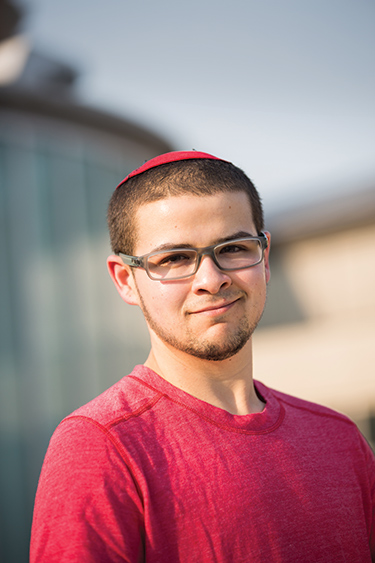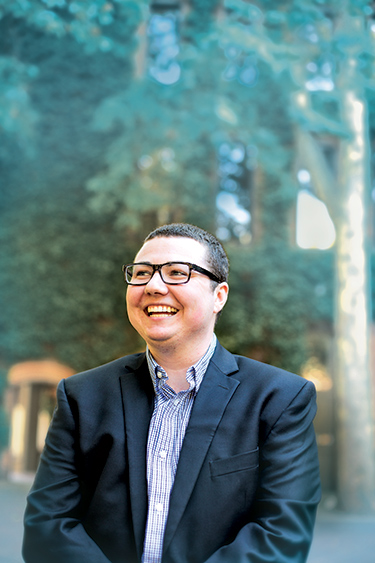

He grew up eating sun-ripened berries and playing in forests. Mickey Balderas also played football and golf in high school, joined Future Farmers of America and the art appreciation club. In his senior year at Chimacum High School, he served as editor of the yearbook and co-editor of the student newspaper. He also earned college credit through the Running Start program.

Mickey Balderas, 26, is attending the Conservative Yeshiva in Jerusalem with the goal of becoming a military chaplain for the U.S. Army.
On the outside, Balderas was a well-adjusted teen leading a conventional life. But it wasn’t the whole truth. From early childhood, he experienced gender dysphoria, the chronic psychological and emotional distress of never feeling comfortable with the gender with which he was born. By the time he was 14, he had changed his first name to reflect the truth of his transgender identity. By 18, he was giving himself weekly testosterone injections.
Being a transgender man is one part of who Mickey Balderas is. A Jewish Studies major at the UW, he left for Israel in July to spend a year studying at the Conservative Yeshiva in Jerusalem. He plans to return to finish his degree at the UW, where he has found friends as well as resources and support for his transition.
Balderas is one of a number of individuals from the UW community—students, faculty, staff, alumni—who are transgender or searching for their true gender identity. “My ultimate goal is to go to rabbinical school and become a military chaplain in the U.S. Army,” he explains during an interview at a University District coffee shop. In July, the Pentagon announced that it will review its policies barring transgender people from the military and will remove this barrier to service in the armed forces. “If it doesn’t,” Balderas says, “I’ll be happy and do good work as a hospital chaplain.”
For the most part, Balderas has been fortunate. “I had a pretty masculine presentation at a very young age. There wasn’t pressure from the community to be more feminine,” he says. Because he applied to college as a female, he did receive mail from sororities. He worked on formally changing his gender on his University records when he got to the UW.
Balderas lived with his grandparents during high school. When he came out to them as a transgender man, they were supportive, asking only that he keep his family’s last name. However, one uncle, with whom Balderas had been extremely close, frowned on Balderas’ transition from female to male.
“He dragged his feet on (accepting) my gender identity,” says Balderas, 26. “I was annoyed, but I had a lot of compassion because I had had a very consistent gender identity from a young age. I had a clear understanding, but I didn’t begrudge him taking his time. Families can be caught off guard; they need time to mull it over.” It took his uncle several years to adjust.
It’s important to distinguish gender identity from sexual orientation, explains Balderas. Gender identity involves a person’s sense of being female, male or something else. While former Olympian Bruce Jenner’s transition to Caitlyn Jenner opened the conversation nationally about what it means to be transgender, she is an anomaly because she is a public figure with deep pockets. It takes money to get counseling, hormone therapy and surgery, money that many transgender people simply don’t have.

Emerson Sekins, 29, is an activist for Washington Access Fund, a small Seattle nonprofit that serves people with disabilities.
“Being transgender is very expensive. I have access to privilege because of my parents, which is not the case for most folks. Your wardrobe has to be changed. You have to pay to change your name, for a new passport, for doctor’s visits out of pocket,” says Emerson Sekins, ’08, ’13, a transgender man and activist who works for Washington Access Fund, a small Seattle agency that serves people with disabilities.
In 2012, Sekins’ insurer denied medically necessary transition-related care, meaning he had to pay $7,500 out of pocket. Ultimately, he was finally reimbursed just under $1,900 in June 2015. This low reimbursement was because Sekins had to pay an out-of-network provider to receive care. He says this is one of the biggest issues with transgender insurance coverage today.
“There are very few providers in-network [who provide care to transgender people], so people have to pay up front and out of pocket, and even with coverage they are often only getting pennies on the dollar,” says Sekins. This is starting to shift because insurance carriers are contracting with doctors who will provide the care. Insurance coverage isn’t the only problem transgender people encounter in the health care system. Stephanie Page, associate professor in the UW Department of Medicine, is an endocrinologist who treats transgender patients at Harborview Medical Center. “We can’t fail to recognize that there are many transgender people who have been refused treatment from a provider for medical problems that don’t even relate to gender identity,” she says. “It takes courage for them to go to the doctor again.”
Most transgender people are prescribed hormone treatment—testosterone, testosterone blockers or estrogen—that they will need to take for the rest of their lives. While some transgender people choose to have sex-change surgery, others do not. Surgery isn’t so much about cutting away unwanted features or adding desirable ones. It’s more about aligning a person’s outside with what they feel inwardly to treat their gender dysphoria.
Page says the transgender community is ostracized, and that many transgender people are dealing with poverty, health issues and social challenges. “Other risk factors include sex work, incarceration, being disenfranchised, feeling stigmatized and lots of drug and alcohol use. Access to health care is a huge problem,” she says. Fortunately, that’s not the case at Harborview’s clinic on Madison Street near downtown, where many transgender people—especially those with HIV infection—go for care. Of transgender women worldwide, there is a 20 percent prevalence of HIV, according to Page.
Media reports estimate that there are 700,000 transgender people living in the U.S. But there is no data to verify this. Whatever the number, staying safe is a huge concern for transgender people.
“Transgender women, especially transgender women of color, are at risk for violence interpersonally and from strangers. The way trans people are murdered is not subtle. It’s bludgeoning and it’s awful,” says Sekins. At a White House briefing on trans women of color, it was pointed out that in the first two months of 2015, eight transgender women were brutally murdered. Most were under 30 and of color.
The National Center for Transgender Equality and the National Gay and Lesbian Task Force conducted a survey in 2011 of more than 6,000 transgender people. Forty-one percent of those surveyed said they had attempted suicide. Then, there is the increased risk for bullying, sexual assault and job loss. In July 2014 President Obama signed an executive order prohibiting transgender discrimination against federal employees, but only 18 states (including Washington) extend the same protection to their citizens.
Not only is Washington more progressive than most states, its flagship university is known among the transgender community as a kind of safe harbor. “The University is generally a very progressive place and I am grateful to be in a place where there is this acceptance of anyone LGBTQ,” says Terra Hoy, 20, who is making the transition to female and took a gap year to deal with the emotional roller coaster common for those undergoing the process. “I wasn’t a student this year because of my mental health,” she says. Hoy will re-enter the UW this fall as a junior with the aim of earning a degree in nursing and public health.
Hoy says throughout her adolescence, she had a feeling of uneasiness. “I felt I was different from my peers, different not just in the color of my skin, my ethnic background [Hoy is Cambodian; her parents fled during the genocide of Pol Pot], or even my questioning of gender roles. I blamed this mindset on my racial background, along with experiencing the awkward stages of puberty and teenage angst,” she says.
The issues Hoy faces include everything from medical bills to safety concerns, employment and bathroom breaks. Finding gender-neutral restrooms is a big issue for transgender people. “Suddenly, making it through the day is more challenging by tenfold. And I consider myself one of the lucky ones,” she says.
Balderas adds, “I feel very positive about my experience at the UW as a transgender student but I also have a lot of privilege around it and maybe a kind of naiveté because I never acted as a female in the campus setting.”
While being transgender is central to identity, it isn’t the whole story of who a person is. “It’s always tough to make the adjustment, but people know me and I haven’t fundamentally changed,” says Sekins, 29. “I’m still a history dork who enjoys puns.”
“People’s ability to connect has really improved because of the Internet. Students find community in ways they never could before.”
Jen Self, director of the Q Center
The UW’s Q Center, which is celebrating its tenth anniversary, welcomes students, staff and faculty who are transgender or in the process of transitioning. The Q Center opened when students approached the UW’s then president, Richard McCormick, about the lack of safe spaces on campus for queer students. “Without the Q Center,” Sekins says, “my experience would have been vastly different. It was a place on campus where you could talk about your experiences with other people.” Balderas also credits Delta Lambda Phi, a fraternity for sexual minorities that has had a presence at UW since 2001, for giving him support. “It’s a very strong fraternity with robust programs,” recalls Balderas, who served as president of the chapter.
Jen Self, ’05, ’10, director of the Q Center since its inception, says she has seen the language and students’ understanding of gender change rapidly over the last five years. “People’s ability to connect has really improved because of the Internet. Students find community in ways they never could before,” she says. Self reaches out campuswide to work on problems facing transgender students. For example, two big issues plaguing transgender students are finding gender-neutral bathrooms and housing. Michelle Primley Benton, administrator for North Campus and Diversity for the UW Department of Food and Housing Services, says that next year the UW will broaden gender-neutral options for housing to include all of the new residence halls on west campus as well as Haggett Hall, which has provided gender-neutral bathrooms and living quarters for several years.
When a young person is juggling college life, work, academic challenges and social pressures, transitioning to a new gender identity can be especially stressful and confusing. About 60 of these students each year seek out counseling from Ryli Webster at the UW Hall Health Mental Health Clinic. Webster says that in the past 10 years, she has seen things change for the better. “There was a lot less acceptance in families. Some of this could be regional. Families can be a lot more accepting on the West Coast,” she says.
Another challenge is that someone who enters the UW with a name, say, Michael, and then transitions to Michelle, may find herself “outed” when a professor calls roll. UW staff is working on giving students an easy option to change gender on University forms. The larger problem transgender students face is changing gender on federal financial aid forms.
Not all the transgender people in the UW community are students, however. Roberta Dalley, a UW faculty radiologist and transgender woman, has worked at the UW for 26 years. She transitioned in 2011. “I have to give a lot of credit to Norm Beauchamp, professor and chair of radiology. When I came out to him in 2010, his first words were, ‘How can I help?’” says Dalley. “I have never had anyone be purposefully malicious or make negative comments to me. I am saying this from the standpoint of economic and professional privilege because I am a physician and I am white,” she adds.
Danni Askini, a transgender woman who is executive director of the Transgender Justice League in Seattle, has taught an elective class with Dalley for about 35 UW medical, nursing and social work students over the past two years. They learn what’s involved in making the transition to another gender and how to care for transgender patients.
More than a year ago, the Washington state insurance commissioner issued a bulletin saying all plans had to remove gender exclusions and extend transgender coverage. Beginning Jan. 1, 2015, coverage had to be provided for mental health care and hormone treatment. Surgery benefits were slated to begin this past July. Even if surgery is covered, there is another problem: There are very few surgeons who are experienced at changing genitalia. None practice in Washington state.
Plus, Dalley says, “Just because it is covered doesn’t mean the insurance companies won’t deny it. Transgender care is new coverage and it’s not going well right now.” Medicaid is considering adding this coverage. The key to the insurance commissioner’s bulletin is based on parity, meaning if insurers pay for mastectomy for breast cancer, they must pay for it for transgender men.
For transgender women, especially, the outward presentation is vital. The question of appearance can be one of life or death—Askini has been beaten so badly, she has been hospitalized several times, once when she was recovering from chemotherapy treatment. Maybe Stephanie Page, the Harborview endocrinologist, sums it up best: “People need to open their minds about this and not stigmatize transgender people for the choices that they make. By being tolerant and open-minded, we can all be contributors to society. There is no role for hate in anything we do.”
A transgender child is not a “tomboy” girl. Or a boy who likes to play dress up. But children as young as two can say, “I am a girl” when they have been born a boy, and vice versa.
Psychology professor Kristina Olson and her team in the Social Cognitive Development Lab are tracking the development of transgender, gender variant, and gender nonconforming children. Her preliminary research shows that even at a young age, a child’s gender identity at a young age holds true. Her early research also indicates that family support influences a transgender child’s mental health. Children whose families support their gender identity, even if it’s not the one that aligns with their sex, experience much less anxiety and/or depression compared to children who are not supported in their gender identity.
Lack of support is when parents say things like, “No, that’s not how boys act and you’re a boy,” or when they punish or shame the child.
Olson’s research group has asked children questions and given them computer tasks that measure implicit gender identity or the speed with which children associate themselves with boys versus girls. The researchers find that transgender girls show just as strong an association with girls on the test as girls who are born girls. The same holds true for boys.
Olson is now leading a national longitudinal study of development in transgender youth, the first large scale study of its kind. She and her research group are recruiting 200 children between ages three and 12; they plan to follow them into adulthood.
To learn more about Olson’s work, go to https://depts.washington.edu/uwkids/